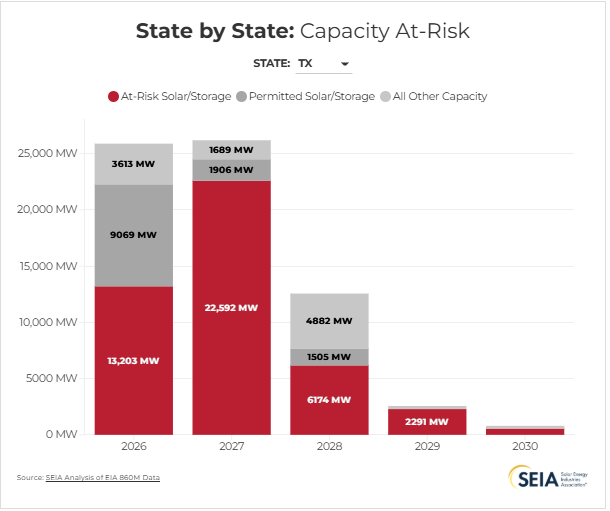SEIA: Political attacks threaten half of all planned U.S. power capacity
Political attacks on solar and storage are threatening over 500 projects totaling nearly 116 GW, or more than half the power planned to be built through 2030, said the Solar Energy Industries Association.
Solar has taken a hit from political attacks, including the One Big Beautiful Bill Act and executive and agency actions aimed at curbing solar development. After years of growth, Wood Mackenzie forecast that solar installations may decline 1% annually through 2035.
The Solar Energy Industries Association (SEIA) released a report saying that political attacks are threatening 500 U.S. solar and energy storage projects totaling nearly 116 GW of capacity, or about half of all planned capacity additions nationwide through 2030.
“This blockade is undermining American energy security, driving up costs for families and businesses, and exacerbating the ‘energy emergency’ that the Trump administration itself declared earlier this year,” said SEIA in a press statement.
New SEIA analysis of data from the Energy Information Administration (EIA) shows that 73 GW of solar and 43 GW of storage projects have not yet received all necessary federal, state and local permits and are at risk of being targeted by the administration. The projects, spread across 44 states, would produce enough electricity to power 16 million U.S. homes.
Solar and storage projects developed on federal lands now face “final review” from Trump-appointed Secretary of the Interior Doug Burgum’s office, leaving many to be “trapped in limbo,” said SEIA.
“And this extends well beyond projects on public lands,” said SEIA. “Many solar and storage projects located partially or entirely on private property are now being entangled in a myriad of federal reviews.”
SEIA said federal obstruction erodes private property rights and local decision-making, inserting Washington bureaucrats into projects that landowners and communities want to host. It poses a risk to landowners, farmers, ranchers, and private investors that even if your project complies with regulations the federal government can still pull the plug, said SEIA.
Eighteen states have over 50% of their planned electricity capacity at risk of being blocked. Many of these states, including Texas, Virginia, Arizona, and Nevada, are expected to lead the country in energy-intensive data center growth. The report from SEIA tracks planned capacity and what is at risk state-by-state on a dashboard here.

Visit SolarPowersAmerica.org to contact your representatives and demand action to restore the permitting of solar and storage projects.
